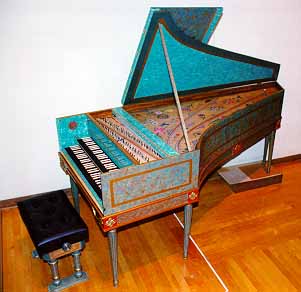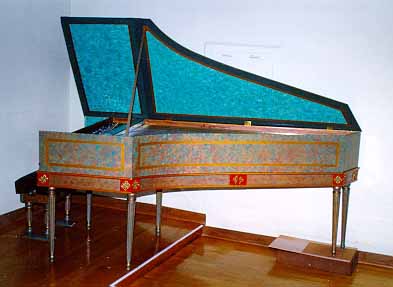Grace St. Pauls Episcopal Church
Tucson, Arizona and the Story of Hubbard Kit #2301
Harvey Nelson notes that "the idea of
a harpsichord for our church originated with Henry Dirtadian, Lou Heindel and myself. We
had all recovered from heart surgery and wanted to do something in Thanksgiving and also
to add to the already excellent music program of the church. The 'idea' took hold and in
May, 1996, the Vestry approved a cash loan to start "Project Pluck" and a French
Double kit was ordered from Hubbard."

Construction was started in June, 1996. All work was
done in a workshop set up by Harvey Nelson in the undercroft of the church in a room
allocated by the Vestry for the project. At this time, Mr. Dirtadian's workload would not
permit him to participate on a day-to-day basis, but he was always available when extra
hands were needed, and Mr. Heindel had to drop out for personal reasons. So Nelson, by
default, became the sole builder.

The soundboard was decorated by Mrs.
Dirtadian (Rosie) and daughter Lucine. As described by Mr. Nelson, " We had decided
from the beginning that we wanted the soundboard to be decorated more or less in the 17th
century style (flowers, birds, butterflies, edging, etc.). We researched that style and
after much agonizing and prayer Rosie volunteered, with not a little encouragement from
Henry, to attempt the task. The instrument with the soundboard installed was moved into
their living room where it stayed for a month while she, Lucine and Henry worked at the
decoration. It turned out to be beautiful and is always the subject of comment whenever
the instrument is on view. Since this is a church instrument, we added a bunch of grapes
and a sheaf of wheat as symbolic of the bread and wine. To add a Southwestern flavor, I
requested some chile peppers. Three of them were added just in front of the jack gap on
the left side, representing the Southwest (and the Trinity!!!)."

A few "Nelson" custom items were
installed: Gilded moldings and medallions were added to the apron stand, intarsia roses
were inlaid on the inside of the cheeks, a fancy border fret molding was inlaid on the gap
edge of the soundboard, a custom made adjustable artist bench with matching Louis XVI legs
and finish was made and a dark staining varnish was used to highlight the hitchpin
moldings and the inside of the case which "gives a sort of framing effect to the
decorated soundboard."

This varnish was the only solvent based
material used on the entire instrument because the use of such material was inappropriate
in the enclosed spaces of the church. Nelson's experience as a chemical and aerospace
engineer led him to use more modern finishes which "are equal to, if not superior, to
the traditional ones." Accordingly, water base finishes were used to complete the
remainder of the instrument.

The finish on the main instrument, music
stand, and custom bench consists of five hand sponged layers using, in specific order,
three different textured sponges. This was covered with seven additional coats of gloss
material to give depth (12 layers in all). Molding highlighting was accomplished with gilt
material, in some cases antiqued. The basic colors involved were vertigris, copper, gold,
white and several shades of green and blue.

Mr. Nelson concludes: "It was a
personal journey that is impossible to describe. As one progresses through the various
stages of construction, gains and perfects various skills, with the help of God, you are,
in the end, left speechless with the physical beauty coupled with hearing it's musical
voice. I think, being so closely involved on a day to day basis (the old trees and forest
thing) one has to depend on and listen to comments and reactions to truly appreciate the
'whole enchildada'"
At the request of Harvey Nelson, the
completed instrument was "tested" by Martha Salzman, a professional
harpsichordist who lives in the area, who was asked to give her impression and comments on
the regulation, action, voicing, etc., of the instrument. Nelson comments: "After
playing Bach, Scarlatti, Soler for about an hour and a half using all of the tonal
resources, she stated that she was 'thrilled that Tucson had a new excellent instrument to
add to the musical resources available'. She particularly commented about the bass quality
and the lightness of touch on both manuals and when coupled, and had only a few
suggestions for touching up the voicing and touch on specific notes." Ms. Saltzman
has since performed public recitals on the instrument in the church as part of Mr.
Dirtadian's fund raising plans to pay for the instrument and she will perform a dedication
recital on Sunday, November 16th. An accomlished performer, Ms. Salzman received a
Bachelor's Degree and Performer's Certificate from the Eastman School of Music, where she
was a George Eastman Honorary Scholar, and a Master's Degree from the University of
Illinois in Urbana where she also was a faculty member for several years. She also studied
with Albert Fuller and Igor Kipnis and has performed in recitals and with chamber groups
in the U.S., England and Europe.
